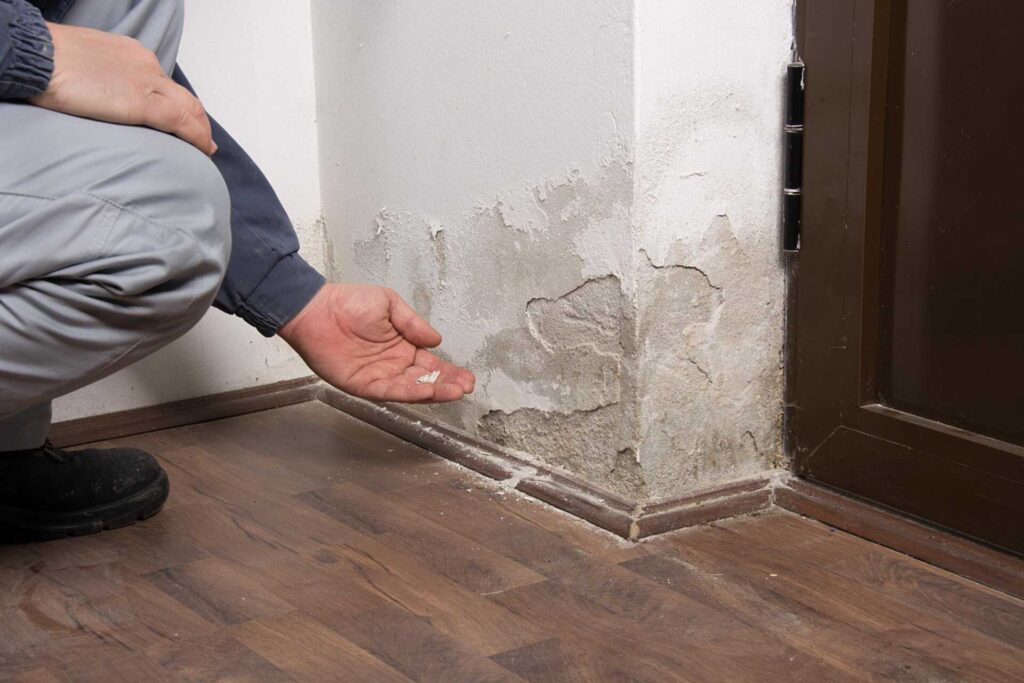
Contents
You may not realize that mold repair solutions go beyond just surface cleaning; they demand a systematic approach to ensure effective removal and prevention. Understanding the underlying causes of mold growth and addressing them is vital to long-term success. From identifying the type of mold to implementing preventative measures, there are essential steps to ponder. What steps can you take to ensure mold issues are managed thoroughly and efficiently?
Key Takeaways
- Conduct mold testing for accurate identification and extent.
- Address moisture sources like leaks and humidity.
- Prioritize safety with protective equipment during removal.
- Use appropriate cleaning solutions for different areas.
- Implement long-term solutions with professional expertise.
Identifying the Mold Problem
When it comes to dealing with mold issues in your home or workplace, the first essential step is identifying the mold problem accurately. Mold testing is a significant aspect of this process. By conducting mold testing, you can determine the type of mold present, its concentration, and the extent of the infestation. This information is crucial for implementing the most effective mold repair solutions.
Moisture control plays a notable role in mold prevention and management. Mold thrives in damp environments, making moisture control indispensable in inhibiting mold growth. By addressing any sources of moisture in your home or workplace, such as leaks or humidity issues, you can create an environment that’s less conducive to mold development. This proactive approach can help you avoid mold problems in the future.
Proper identification of the mold problem through testing and maintaining moisture control are key steps in effectively managing mold issues. Taking these measures ensures that any mold repair solutions you implement are targeted and efficient. Remember, accurate identification and addressing of the root cause of mold growth are fundamental for long-term mold prevention and a healthy living or working environment.
Removing Mold Safely
To safely eliminate mold from your home or workplace, meticulous attention to detail and adherence to proper procedures are essential. When tackling mold removal, it’s important to prioritize your safety by wearing appropriate protective equipment. This includes gloves, goggles, and a mask to prevent exposure to mold spores. Proper ventilation is also vital during the removal process. Open windows and use fans to ensure fresh air circulation and prevent the spread of mold particles.
Before starting the removal process, assess the extent of the mold growth. For small affected areas, you can clean the mold yourself using a solution of water and detergent. However, for larger areas or severe infestations, it’s best to seek professional help to ensure thorough elimination and prevent recurrence.
When removing mold, use a scrub brush or sponge to clean the affected surfaces thoroughly. Remember to dry the area completely after cleaning to discourage mold regrowth. Dispose of any contaminated materials in sealed bags to prevent spreading mold spores to other areas.
Once the mold is removed, continue to monitor the area for any signs of regrowth and address any moisture issues promptly to prevent future mold problems.
Preventing Mold Regrowth
To prevent mold regrowth effectively, it’s critical to address any underlying moisture issues that may have contributed to the initial mold growth. Moisture control is paramount in mold prevention. Verify that any leaks in pipes, roofs, or windows are promptly repaired. Additionally, maintain proper ventilation throughout your home, especially in areas prone to dampness, like bathrooms and basements. Adequate ventilation systems help in reducing humidity levels, making it less hospitable for mold to thrive.
Keep indoor humidity levels below 60% by using dehumidifiers or air conditioners. Regularly inspect and clean HVAC drip pans and confirm they aren’t clogged. Use exhaust fans in kitchens and bathrooms to reduce moisture buildup. Consider using mold-resistant products when renovating or building areas susceptible to mold growth.
In areas with high humidity, such as basements, consider using a vapor barrier to prevent moisture from seeping through walls and floors.
Monitor and address any condensation forming on windows. Validate that gutters and downspouts are clear to prevent water from pooling near the foundation of your home.
Repairing Water Damage
Addressing water damage promptly is vital to prevent the development and exacerbation of mold issues. When dealing with water damage, the first step is to focus on moisture control. Begin by identifying the source of the water intrusion and taking immediate steps to stop it. Extract any standing water using appropriate equipment like wet vacuums and dehumidifiers to dry out the affected areas thoroughly. Proper ventilation is essential to facilitate the drying process and prevent lingering moisture that could lead to mold growth.
After addressing the moisture issue, the next crucial aspect of repairing water damage is conducting structural repairs. Inspect for any damage to walls, floors, ceilings, or other building materials. Replace or repair any compromised structural elements to ensure the integrity of your home and prevent future water leaks.
It’s important to be thorough in this process to avoid hidden pockets of moisture that could later contribute to mold growth.
Consulting Professional Services
When considering the complexities of mold repair, seeking professional services can provide expert guidance and efficient solutions for addressing mold issues effectively. While some individuals may opt for DIY methods to tackle mold problems, it’s essential to recognize the value that professional services bring to the table.
Professional mold repair services offer a level of expertise that goes beyond what DIY solutions can provide. These experts have the knowledge and experience to accurately assess the extent of mold damage, identify the root causes of mold growth, and implement effective long-term solutions. By consulting with professionals, you can rest assured that the mold issues in your home will be addressed thoroughly, reducing the likelihood of recurrence.
Moreover, professional services often utilize advanced tools and techniques that aren’t readily available to the average homeowner. This enables them to carry out thorough mold remediation processes that target mold growth at its source, ensuring a more permanent solution to the problem.
While DIY methods may offer temporary relief, professional services focus on delivering lasting results that promote a healthier indoor environment for you and your family.
Summary
By accurately identifying the mold problem, safely removing it, preventing regrowth, repairing water damage, and consulting professional services, you can effectively tackle mold issues. Just like a skilled detective unraveling a mystery, each step in the process reveals more about the hidden culprit lurking within your walls. With a strategic approach and attention to detail, you can ensure a mold-free environment and a healthier living space.
Recent Posts
Why Choose DIY Water Extraction Methods?
Water damage can escalate quickly, making timely action vital. By opting for DIY water extraction
3 Steps for Effective Water Extraction in Commercial Properties
When dealing with water damage in commercial properties, water extraction is the first crucial step.
Expert Water Extraction for Commercial Properties
Water damage in commercial properties can be a catastrophe of monumental proportions, threatening your entire
